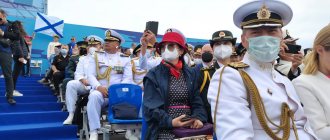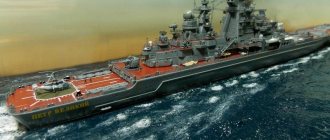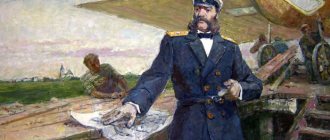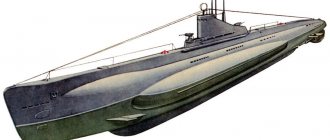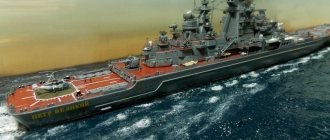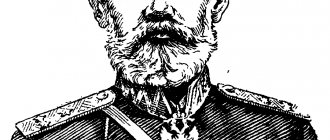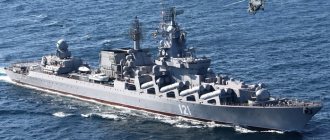Eagles and elephants
The first Russian ship is considered to be a 22-gun three-masted galliot, built in 1669 on the Oka River, in the village of Dedinovo and intended for escorting merchant ships from the Eastern countries along the Caspian Sea and the Volga. The decree of Tsar Alexei Mikhailovich read: “The ship that was made in the village of Dedinovo ... should be given the nickname “Eagle.” Put an eagle on the bow and stern, and on the banners... sew on eagles.”
This is how the first ship name appeared in the Russian Navy. The eagle is a heraldic symbol of royal power in Rus', depicted on the state emblem and on the first naval flags; It is no coincidence that the name “Eagle” was retained for a long time in the Russian and Soviet Navy.
The creation of a strong regular fleet was the exclusive merit of Peter I; without this, the struggle for access to the Azov and Baltic seas would have been pointless. It is known that Peter managed to create 147 battleships and frigates, many small ships - this is the result of the 29-year activity of the reformer king. Documents show that he attached great importance to the names of ships and vessels, understanding their great political importance. This is a reflection of the greatness and power of the Russian state, helping to raise international prestige, as well as maintaining national patriotism and high military spirit, preserving the memory of the military victories of the army and navy.
Peter the Great had priority in the formation of many traditions in determining the names of various types of ships and vessels, and these traditions subsequently became the foundation for developing a system of names (nominations) in the domestic fleet. He also laid down another tradition - the names of ships in Russia, the head of state always maintained.
At first glance, it is difficult to find any system in the nominal list of ships and galleys that were included in the first large formation of the Russian fleet - the Azov flotilla (1696-1702). Nevertheless, there was a system - most of the names were chosen to express the ideas of the high morale of the sailors, the strength and power of the Russian fleet.
Take, for example, the Azov barkalon called “Elephant” (“Eliphant”), and the ship’s motto matches: “The evil are dashing.” Perhaps the matter is not in symbolism, but in the family coat of arms of the creator of the Azov flotilla - F.M. Apraksin, where this mighty animal also flaunts. Such is the mystery, although most likely, the last option is still far-fetched (elephant ones, of course), because “elephants” were found in abundance in all fleets. The symbol is too impressive and characteristic - it contains strength, durability, reliability and power
But the title “Guarding Crane” probably harmoniously combines allegory and Russian folklore.
The symbolic-allegorical nomination, revealing the name through the motto, was an element borrowed from Western European countries.
Galley fleet under Peter I
Peter's fleet began with galleys, since they were best suited to the needs of the fleet. In 1710, craftsmen gathered from all over the country to build rowing ships. The choice in favor of galleys was explained by a number of reasons:
- The vessels are versatile and suitable for both combat and patrol;
- Relatively cheap to produce, ship timber was very expensive, and Russian pine was not only cheaper, but also more suitable for construction;
- The low draft, rarely exceeding two meters, was very important, since large Swedish battleships could not fully operate off the coastline.
The vessels could accommodate up to three hundred oarsmen, and the oar weight reached ninety kilograms, with up to five people per oar. The maximum speed reached six knots and sometimes more, while the rowers made up to twenty strokes of the oars per minute. Since oars were located along the entire side, the guns were located only in the bow and stern of the ship, which also influenced the tactics of combat.
Description of the case
Russian galleys had only a basic description in common, these were oars on the sides and cannons in front and behind, the rest constantly changed from model to model. There is little information left about the first galley, which arrived disassembled, it could be classified as a half-galley, its length was a little more than thirty-eight meters, with a beam of nine and a draft of one meter and eighty centimeters.
From that moment on, the construction of a variety of models began, from twenty to twenty-four cans, up to fifty-three meters in length, relatively narrow no more than seven hundred and thirty centimeters. They were armed with up to twenty-seven cannons; these were the first and last goliaths of their era; later Peter abandoned them in favor of more modestly sized ships.
Options for installing a falconet and guns on the bow of a galley
Galleys of the Turkish style had a long hull and had dangerously low sides above the water, which often caused them to sink. In front there was a ledge raised to the top, to which the foremast was attached. Behind this ledge there was a platform with large-caliber guns. The platform for the movement of people along the ship was called a curonian, it was covered with a tarpaulin, and at the stern it was crowned with a superstructure-cabin made of wooden beams or arches, on which a tent was stretched.
Weapons and combat tactics
Due to their low armament, the galleys were never lined up for defense. Thanks to its speed characteristics, it became a means of attack. In the front part, as a rule, there were two or four cannons, which “fired back” until the moment of ramming, and in their tactics they were somewhat reminiscent of Japanese kamikazes. Quickly emerging from cover, the galleys rammed the enemy, after which they boarded the enemy. Often the rowers were the first to suffer in a firefight, since they had no cover, partly because of this, during the rowing attack, what is called “like the last time,” their survival depended on the speed of the attack.
Heraldry and mottos
This rule acquired particular force after the return of Peter I from his first trip abroad, during which he became interested in emblems, symbols and allegories. Here are just some of the names given to them, revealed with the help of the corresponding mottos: “Bomb” - the motto “Woe to the one who gets it”, “Turtle” - “With patience you will see the end of the matter”, “Sleeping Lion” - “His heart is watching”, “Sword " - "Show me the essence of the laurel crown", "Three glasses" - "Keep moderation in all matters."
Very often, mottos and names were written together on stern decorations, so ships were often named with mottos along with their names; for example, in the order for the Azov flotilla dated July 26, 1700 it is said that “... captain Ivan Bekman needs a sea caravan for three ships called: “By his death they are healed”, “Fortress”, “The door is open”, half a fathom of wood for boiling resin . The first of the ships indicated in the order is “Scorpio”, to which this motto belongs.
28-gun ship "Standard"
Documents indicate that Peter I and his assistants borrowed many names and mottos from popular Western European armorial books and emblematic collections. The role of the main publication, of course, was played by the book “Symbols and Emblems”, published in Amsterdam (1705) by special order of Peter; presented in four languages, including Russian, it contained 840 drawings with mottos and brief annotations that explained the system of symbolic and allegorical elements.
Comic, mischievous titles also appeared: “Featherweight”, “Hare’s Run”, “The Color of War”, “Wind”, “Fearlessness”, “Fear”, “Libra”, “Three glasses on the table”, “Open gates” ( the latter meant the path to the southern seas opening for Russia).
Since the majority of shipbuilders and sailor officers invited from abroad did not know the Russian language, for greater mutual understanding, many ships had two or more names, most often Russian and its translation into Dutch, English, German, French, for example, “Baran” " - "Trumel", "Hedgehog" - "Igel", "Stone" - "Stein". There were ships with three or four names: “Connection” - “Unia” - “Einichkeit”, “Fearlessness” - “Sunderban” - “Sonderfrest” - “Onderfrest”, and even with six: “Good Beginning” - “Blessed Beginning” — “A good beginning” — “Gut anfagen” — “Gut begin” — “De segel begin.”
Such multilingualism, completely legal, in the spirit of those years, is reflected in many official documents. Perhaps, in some cases, such multiple names were done and encouraged by Peter specifically, for advertising purposes and to strengthen the authority of the young fleet.
The name of the 58-gun ship “Goto Predistination”, built in 1700, in Russian meant “God’s foreknowledge of this,” but on the stern it was written in Dutch so that the meaning of the name would be more understandable to European ambassadors and specialists; so resonant and promising, it had a deeply symbolic and political meaning. The fact is that, for reasons of national prestige, the construction was carried out without the help of foreign craftsmen, according to the drawings of Peter himself; this first “sovereign” ship of this rank was created exclusively by Russian hands.
The tsar also came up with a stern decoration that organically combined with the name - the kneeling figure of the Apostle Peter, and behind him, against the backdrop of a calm sea, ships were visible, a dove was flying across a cloudless sky, carrying a myrtle branch in its beak. The allegorical meaning of the composition is clear: the anticipation of the transformation of Russia under the rule of Peter into a strong naval power and the desire for a speedy peaceful resolution of the war. However, the Dutch attache Van der Gults, who was present at the launch of the ship, indicated in his report the growing power of the Russian fleet and mentioned the construction of a “very beautiful ship” - “The Apparition of Peter”. For him and Europe, it really was a “phenomenon”: the birth of the Russian regular fleet.
When building large ships, the rule of “deciphering” names through compositions of bow figures and stern decorations became mandatory. Drawings, drawings, engravings, models, decorative decorations often provide the key to understanding the meaning of each name. It is worth highlighting a number of names that the young king gave to the firstborn of various classes of ships.
- In 1694, he ordered the only two military ships loaded with goods to be sent from Arkhangelsk to Holland - “St. Paul” (keeper of the keys to heaven, in this case the keys to the sea were meant) and “Holy Prophecy”. It was ships with such “prophetic” names that had the honor of being the first to carry the glory of Russia across foreign seas.
- Peter gave the name “Principium” to the very first and best of the galleys launched at the Voronezh shipyard in 1696, which translated from Latin meant “The Beginning,” thus marking the birth of the Russian galley fleet; on this ship the tsar led the “sea caravan” heading to storm the “Azov”; on it he drew up the “Decree on Galleys”, which was the prototype of the future first “Naval Charter”.
- In 1702, Russian troops stormed the Noteburg fortress, which actually meant the following: after a ten-year struggle, Russia finally reached the Baltic Sea. The double-headed eagle depicted on the royal standard held in its beaks and claws maps of the seas that already belonged to Russia: the White, Caspian, Azov, Baltic. In 1703, this event was marked by the construction of the first frigate of the Baltic Fleet, the 28-gun Shtandart.
- The first battleship built at the St. Petersburg Admiralty was the 54-gun ship Poltava, launched in 1712, named in memory of the victory in the largest land battle with the Swedes.
- The end of the grueling Northern War (1700-1721) was marked in Russian history by the appearance in the Baltic of the new 74-gun battleship Nystadt, named after the Finnish city where the peace treaty was concluded.
Peter I marked memorable historical events with the names of ships, forcing them to serve the glory of the Russian fleet and the education of patriotism.
At the same time, he could afford to come up with such “non-standard” names as “Beer-Dragers” (“Beer-Carrier”), “Wayne-Dragers” (“Wine-Carrier”), “Gut-Dragers” (“Good News”) , "Thankful Triumph"; There were also names in a foreign style - “Fligel-Fam” (“Flying Glory”), “Yagd-Hund” (“Hunting Dog”), “Wind-Hund” (“Greyhound”).
58-gun ship "Goto Predistination" ("God's Foresight")
During the creation of the Baltic Fleet, features of national traditions increasingly appeared; emblematic names were less common, which were replaced by more specific ones that had a certain spiritual meaning.
At the beginning of the 18th century, a nomination tradition was born, which celebrated the return of Russia to the shores of the Baltic, the liberation of primordially Russian lands, and the construction of cities; in 1703, the frigates Petersburg, Kronshlot, Dorpat, and Narva began to be built at the Olonets shipyard. A logical continuation of these names can be considered “Riga”, “Vyborg”, “Pernov”, “Ingermanland”, “Moscow”, “Astrakhan”, “Derbent” - all of them expressed the Russians’ love for the Motherland, pride in the return of their ancestral territories.
Toponyms were used even more widely during the construction of ships of the Caspian flotilla in 1724; the beginning of another tradition was laid by the first traditions of the army and navy; The ships “Azov”, “Poltava”, “Lesnoye”, “Gangut” became the memory of the glorious battles of Peter the Great.
The first Russian war galleys
Galleys belong to sea-going sailing and rowing vessels, where the main moving force was oars driven by slaves, convicts or the soldiers themselves. The design also included two or three masts with slanting sails. Despite the fact that galleys were used as merchant ships, their primary purpose was combat, due to their speed, enormous for their time. It is the galleys that hold the record for the duration of their existence as part of the armed forces of their states; they existed for about one and a half thousand years.
Galley "Dvina" Russia 1721
The first galley arrived from the Netherlands disassembled at the end of the seventeenth century to Arkhangelsk, but the tsar ordered it to be sent to the village of Preobrazhenskoye without assembling it. So this galley became a model for the creation of twenty-two more ships that joined the squadron under the flags of Admiral Lefort, the model also entered service.
Baptism of fire
After the unsuccessful siege of Azov in 1695, Peter became especially passionate about creating a fleet capable of fighting battles from the sea. All because of the Turkish fleet, which transported supplies to Azov by sea. Over the winter, having built 23 galleys according to the Dutch model, 2 galleasses, 1300 plows, 3 hundred boats, 4 fire ships, a new campaign was ready by spring.
In May, a Russian flotilla under the command of the emperor appeared near Azov, blocking the supply of supplies from sea and land; after a fierce siege, the Turks finally surrendered. This was Russia's first victory thanks to the efforts of the fleet, but the real battles were yet to come.
Battle of Cape Gangut
One of the historically important naval victories was in the Ganguda naval battle. A serious Swedish group of thirty ships, half of which were linear frigates, was defeated by 20 Russian ships, mostly galleys. Peter immediately understood that he could not defeat a heavily armed, experienced and outnumbered enemy with a frontal attack. The Swedes' self-confidence played a cruel joke on them; Peter misled the enemy by starting to build a portage to drag the galleys across the isthmus. Swedish Vice Admiral Watrang decided that the Russians wanted to transfer their forces in order to attack from the rear and immediately sent some of the ships to meet them, and some to reserve. The weather also played into the hands of the Russians; the calm that established before the battle pinned down the sailing ships, seriously limiting their mobility. The Swedes, taken by surprise, did not have time to regroup, and the ships of Rear Admiral Taube, who arrived to help, hastily retreated, believing that the entire Russian flotilla had advanced towards them.
Kings and celestials
Peter I himself approved and came up with names for ships and vessels, chose the days of laying and launching, which in itself could not but affect the use of ship names in ideological politics; Its main goal was to maintain the then dominant worldview and to promote the existing socio-political system.
Two trends were closely intertwined here - the “baptism” of ships with religious names and those given in honor of the reigning persons. These names fostered the loyal feelings of the people, ideas about the inviolability of the monarchy, and the divine origin of power. The ships, named after representatives of the Romanov dynasty, were distinguished by particularly rich decoration - these are “Princess Anna”, “Princess Elizabeth”, “Natalia” (in honor of the mother of Peter I), “Lizet” (in honor of the daughter of Peter I - Elizabeth), the largest The 100-gun ship bore the name "Peter I and II".
The idea of the cult of the royal family and the church contributed to the formation of the tradition of naming ships in honor of saints, whose days of honor coincided with the birthday or namesake of members of the royal house; the celebrations on the occasion of the accession to the throne, the coming of age of the august offspring and, of course, in honor of the numerous divine patrons of the state, army and navy were not forgotten. The laying or launching of ships was timed especially for such occasions; here are just a few of them: “St. Catherine”, “St. Andrew”, “St. Peter”, “St. Elijah”.
Or the first ships from Arkhangelsk (1715): “Gabriel”, “Raphael”, “Selafail”, “Varakhail”, “Archangel Michael”, “Yagudiel”.
Religious names in honor of saints included primarily those on whose days any remarkable events occurred or became known; Thus, the ship "Isaac-Victoria" was named in honor of St. Isaac when news arrived of the victory of the Russian squadron over the Swedes in 1717. The Gangut (1714) and Grengam (1720) victories took place on July 27, the day of St. Panteleimon, which gave rise to launch the ship “Panteleimon-Victoria” exactly one year later.
The Battle of Poltava took place on the day of St. Samson, so he was counted among the patrons of the Russian army, as a result of which the frigate “Samson” appeared in the fleet.
Ancient times
In fact, the history of shipbuilding dates back to small dugout canoes that people used to develop rivers and lakes in ancient times. At first, reservoirs were exclusively hunting grounds for them, but with the development of shipbuilding they turned into convenient transport arteries for transporting goods.
The history of shipbuilding goes back to ancient times, since the most primitive ships appeared long before the invention of the wheel, and therefore the cart. Man began to explore the sea at the very dawn of his development. In mythology you can find many descriptions of travel by water, often describing in detail how people equipped and built the very first ships. It was always indicated that this was the will of the gods. This is exactly what happened with Noah's Ark.
The history of shipbuilding since ancient times actually begins with a canoe discovered in the area of the Dutch Groningen. It was approximately built in 6315 BC. Already two and a half thousand years BC, sea and river vessels were distinguished by their diversity. Separate ships and boats were made for transporting passengers and transporting goods.
They were propelled by oars, poles and sails. Then the ships were mainly merchant, military and fishing. Over time, analogues of modern yachts appeared that were used for recreation.
For example, Emperor Caligula, who ruled in the 1st century AD, ordered the construction of a ship for a recreational trip on Lake Neli. This is how historians explain the unusual design of the ship, which was flat and wide, and its internal flooring was lined with marble tiles.
Purchases and trophies
During the reign of Peter the Baltic squadron was replenished with ships purchased abroad: Strafort, Oxford, Lansdow, Randolph, St. Jacob, Armont, Pearl, Leferm and others. Despite the military merits of some of them, these names were not subsequently transferred to other ships. True, there is a ship that left a memory of itself on the map of the Gulf of Finland - in honor of the frigate London that perished in inclement weather (1719), one of the Kotlin shoals is called Londonskaya.
Another way to replenish the fleet is through battle trophies: in total, during the years of the Northern War, the Russians captured about 50 different ships and vessels, including “Wachmeister”, “Astrild”, “Elephant”, “Gedan”, “Esperance”, etc. Most of them became part of the Russian fleet without changing their names; Moreover, subsequently some new ships were given the names of captured ones: “Instead of the frigate “Wachmeister” taken in 1719, make again a frigate of the same name with as many guns as the captured frigate had,” read the decree of the Admiralty Board of August 18, 1728 G.
The tradition of leaving captured ships under the same names lasted in the navy for quite a long time: just remember those that sailed and fought under the Russian flag “Brilliant” (year of the ship’s capture - 1734), “Rhodes” (1770), “Prince Gustav” (1786), “Venus” (1789), “Retvizan” (1790), “Sed-el-Bahr” (1807), “Falk” (1808), “Emgeiten” (1808) and others.
Ships of Peter's times
Types of Slavic ships
In the 12th century, the first decked ships began to be built in Rus'. They were intended to house warriors.
It is known that the Slavs had a variety of ships. For example, one of the most famous is shitik. This is a flat-bottomed vessel with a mounted rudder, which was equipped with oars and a mast with a square sail.
The karbas had two masts that carried sprint or straight raked sails. The Pomeranian boat had three masts and had a straight sail.
The underwater part of the ranshina's hull had an interesting egg shape. Due to this, she could float even when compressed by ice, since in this case she was literally squeezed to the surface. The ship was not subject to deformation, and when the ice diverged, it could plunge into the water again.
XVIII-XIX centuries
After the death of Peter I, there was a certain lull in the history of Russian shipbuilding, but it gave way to a new rise in the second half of the 18th century. Its result was the creation of a full-fledged Black Sea Fleet.
In the 19th century, a classification of ships appeared, which was technically justified. During the reign of Emperor Alexander I, shipbuilding work was reduced, only river shipbuilding was actively carried out. At that time, the bark appeared - a wooden cargo ship that was perfect for its time.
In 1815, the first regular steamship was launched and began sailing between St. Petersburg and Kronstadt.
In 1830, in the capital of the Russian Empire, the cargo-passenger ship “Neva” was put into operation, which had both sails and two steam engines. In 1838, the first electric ship on the planet was successfully tested on the Neva. Ten years later, engineer-general Ivan Afanasyevich Amosov built the first screw frigate, which was called Archimedes.
Shipbuilding enthusiast
And the business, which had barely begun, would have fallen apart if not for the tenacity and persistence of the main “foreman” ─ Afanasy Ordin-Nashchokin. It was through his efforts that it was possible to attract Dutch craftsmen to the work, and to help them bring in three dozen local carpenters from Kolomna and Dedinov. In addition, he managed to find suitable blacksmiths, gunners, as well as woodcarvers and ropemakers. The boyars “thanked” him for this with vicious persecution, considering him an upstart and a conniver of empty ideas. Ignoring a good initiative, they tried with all their might to humiliate and slander its real performer.
Middle Ages
The history of shipbuilding in the Middle Ages in Rus' is distinguished by the emergence of organized shipbuilding. It is believed that it originated in the 15th century, when a shipyard for fishing vessels was founded on the basis of the Solovetsky Monastery.
In the 16th-17th centuries, Zaporozhye Cossacks began to massively build “Seagulls”, which they used to go on raids on the Turks. The technique was similar to that used by the people of Kiev. They sought to increase the size of the ship towards the middle. To do this, when chiseling, several boards were nailed to the sides.
New centers in the history of shipbuilding in Russia appeared under Ivan the Terrible when he captured Astrakhan and Kazan. Under Boris Godunov, the first attempts were made to found a navy. True, they failed.
In 1634, the first marine vessel of a foreign design in our country was built at the shipyard in Nizhny Novgorod. This played an important role in the history of the development of shipbuilding. It was a ship called Frederick. By 1669, the boyar Ordin-Nashchokin completed the construction of the ship "Eagle".
Sovereign command
The appearance of the first warship "Eagle" in Russia was preceded by completely peaceful events. In 1664, the Persian Shah Abbas II granted Russian merchants the right to trade duty-free in his domains. This sign of goodwill opened up wide opportunities for Russia, but in order to realize them, a very significant problem had to be solved - ensuring the safety of merchant ships on their way through the Caspian Sea. This required a navy, which did not yet exist, but which had to be built.
It was necessary to start somewhere, and the sovereign who ruled in those years, Alexei Mikhailovich ─ the father of Peter I (his portrait is given below) ─ gave the order to build near the village of Dedinovo, which is not far from the place where the Moscow River flows into the Oka (126 versts from the capital), a shipyard designed for the construction of large ships. At the same time, it was necessary, taking Western models as a basis, to begin laying the frigate. Thus, by the will of Emperor Alexei Mikhailovich, the ship “Eagle” was laid down, which laid the foundation for the entire future Russian fleet.
Ship "Fortress"
“Fortress” is the first Russian warship to sail into the Black Sea and visit Constantinople.
Built in Panshin, near the mouth of the Don. Length - 37.8, width - 7.3 meters, crew - 106 people, armament - 46 guns.
In the summer of 1699, the “Fortress”, under the command of Captain Pamburg, delivered an embassy mission to Constantinople, headed by Duma Councilor Em. Ukraintsev. The appearance of a Russian warship near the walls of the Turkish capital, and the entire Russian squadron near Kerch, forced the Turkish Sultan to reconsider his attitude towards Russia. A peace treaty was concluded between Turkey and Russia. This voyage of the “Fortress” is also notable for the fact that Russian sailors for the first time made hydrographic measurements of the Kerch Strait and Balaklava Bay, and also drew up the first plans of the Crimean coast.
During the stay in Constantinople, many Turkish and foreign experts visited the Fortress and praised Russian shipbuilding. In June of the following year, 1700, the ship “Fortress” with 170 Russian prisoners returned from Turkey to Azov.
Sloop "Mirny"
"PEACEFUL", sailing sloop of war, ship of the 1st Russian Antarctic circumnavigation expedition of 1819-1821, which discovered Antarctica.
At the Olonetsky shipyard in Lodeynoye Pole near St. Petersburg in 1818, the auxiliary ship “Ladoga” was built for the fleet. In an effort to speed up the departure of a high-latitude expedition to Antarctica, they decided not to build a new ship, but to use the Ladoga. When the ship was included in the navy, it was given a new name, Mirny, and reconstruction immediately began. The work was supervised by the commander of the Mirny M.P. Lazarev. By attaching studs to the sloop, they lengthened the stern part, placed a knyavdiged on the stem, and additionally sheathed the hull with inch boards, firmly securing them with copper nails. The hull was carefully caulked, and the underwater part was covered with copper sheets to prevent it from becoming overgrown with algae. Additional fastenings were installed inside the hull in case of exposure to ice floes, and the pine steering wheel was replaced with an oak one. The previously supplied standing rigging, shrouds, stays and other rigging made from low-grade hemp were replaced with stronger ones used on naval ships. The Mirny sloop was a three-masted, double-decker ship armed with 20 cannons: six 12-pounders (120 mm caliber) and fourteen 3-pounders (76 mm caliber). The crew consisted of 72 people.
Dimensions of the sloop "Mirny" according to drawing no. 21, stored in the Central State Archives of the Navy in Leningrad, are as follows: length -120 feet (36.6 m), width - 30 feet (9.15 m). draft - 15 feet (4.6 m). These dimensions increased slightly after the vessel was rebuilt, and the same applies to the displacement of the Mirny.
Military shipbuilding
During the second decade of the 21st century, speaking about the development of shipbuilding in the country, first of all, we are talking about the navy. Naval equipment accounts for up to 70 percent of all orders received by factories. At the same time, a significant part of warships is sent for export.
In providing the world with warships, Russia now ranks second in the world after the United States, accounting for 12% of global military shipbuilding.
Currently, shipbuilding enterprises, which were in crisis throughout the 90s and even the 2000s, are fully supplied with orders. With stable federal funding, their capacity will continue until at least 2022. And these are the most modest forecasts.
At the beginning of a thorny path
Early in the morning of November 14, 1667, after serving a prayer service and blessing, as is customary among good people, we began laying down the ship. However, at first, the newly minted shipbuilders encountered unexpected problems. They began with the fact that the Kolomna forest turned out to be unsuitable for the intended business, and in return it was necessary to transport logs from Murom, where they were harvested on the estate of the local archbishop.
In addition, the carpenters made a mistake. Accustomed to building houses and churches, they were helpless at the shipyard and could not understand what Lambert Gelt, who did not speak Russian, wanted from them. They had to be released in peace, and experienced carpenters had to be sent from the same Holland.
But the main obstacle to the work begun was obvious sabotage on the part of the boyar elite, in the opinion of which the construction of the ship "Eagle" was not a solution to the pressing problem of that time, but only a momentary whim of the sovereign. And in general, the boyars did not see any benefit in creating a military fleet. They reasoned something like this: “Our fathers and grandfathers lived without him, and we will live.”
Kazan campaign. 1552
Map of the siege and capture of Kazan. 02.10.1552
In this campaign, which resulted in the annexation of the Kazan Khanate and surrounding Tatar possessions to the Muscovite state, plows played a key role in transporting troops, equipment and supplies along the Volga water system from Kolomna (100 km from Moscow) to Kazan and back. They carried 150 Russian siege artillery guns, many of which already amazed contemporaries with their size and weight. Their transportation, as well as food for the troops, was provided by the ship's army. There is no exact data on its number, organizational structure and nature of recruitment. One thing is clear: there would not be enough people and plows to support the entire Kazan campaign, and merchants played an active role in supplying the Russian siege troops, delivering many goods on their ships.
The speed of construction and the primitivism of the plows almost turned into a disaster for the Moscow army: on August 24, 1552, a severe storm arose, which was accompanied by a 12-hour downpour, which led to the sinking of many ships with supplies. However, a new batch of plows quickly built on the Upa, Oka and Volga rivers neutralized the consequences of the natural disaster, and active supply continued through the only possible water route along the Volga. After the successful completion of the campaign, the ship's army began to return the main forces of the Russian troops home.
Ancient Kazan. Illustration published in Zhivopisny Zhurnal. Paris, 1843
Current state
After the collapse of the Soviet Union, the entire shipbuilding industry was in crisis. For example, by 2000, the number of decommissioned transport fleets exceeded the number of new ships by 13 times. Moreover, domestic customers were forced to place most orders for new ships at foreign shipyards.
The situation began to improve in 2007, when Vladimir Putin signed a decree on the creation of the United Shipbuilding Corporation. Its main goal was civil shipbuilding. A federal target program was also adopted.
Continuation of ordeals
In such a festive and elegant appearance, the frigate stood at the wall of the shipyard for another whole year before it was able to set off on its first voyage. The reason was the same slowness and negligence of the Russian land officials, who continued to interfere with the matter by all available means.
While the delays dragged on, local residents managed to steal many of the ship's iron and copper parts, which had to be made anew. When Afanasy Ordin-Nashchokin applied to the Pushkar order with a request to send blacksmiths to re-make what had been lost, he was refused. Only the intervention of the sovereign himself forced the clerks to send a blacksmith to Dedinovo, and then only one. The Dutch looked gloomily at what was happening around them, cursed in an incomprehensible language and threatened to leave for their homeland...

